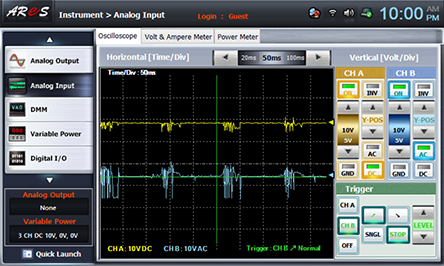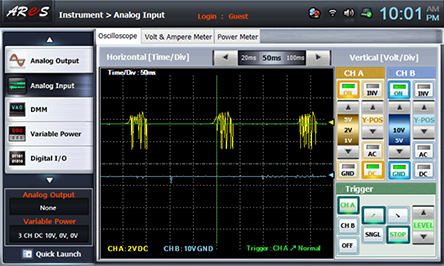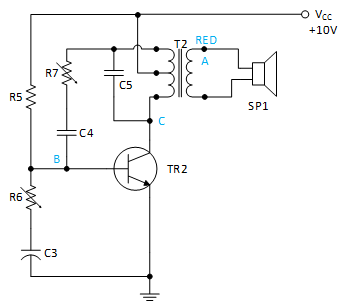PART11Oscillator Circuit
Experiment 2 :Electronic Birdcall Circuit
Theory
Fig.11-3 is an electronic birdcall circuit to which the blocking oscillator is applied. The operation of electronic birdcall circuit is similar to that of blocking oscillator. T2 is an audio output transformer and is used widely to the radio receiver circuit. The center tab of primary winding operates similar to the transformer T1 of blocking oscillator(fig.11-2).
The oscillation frequency is determined by the composition of R7 and C4 for positive feedback operation.

The time interval of the oscillation is determined by the time constant of R8 and C3. If VCC is supplied, TR2 is cut off until the charging voltage of C3 reaches the conduction potential of TR2. When this process is completed, the current flows through TR2 and the birdcall is output through the speaker. The discharging time is and this determines the oscillation interval.
Experiment Process
1. Using Block b of M11 board, make a connection as in fig.11-3.
2. Make the output power of DC power supplier as 10V and connect it to the circuit.
3. Check out if the sound is output from the speaker when the power is applied.
4. Adjust R7 and observe the change of output frequency with the oscilloscope.
- Describe the tone change of birdcall.
- Describe the relationship between R7 and the output frequency.
5. Adjust R6 and describe the change of the birdcall’s interval.
- Describe the relationship between R6 and the interval of birdcall.
6. Measure the voltage waveform of each measure point(A, B, C) using the oscilloscope and record the result in table 11-2.
7. Compare table11-2 and table 11-1 of blocking oscillation experiment.
tab1Experiment 11-2.1
1.Connection(Block b of M11)
1.Power Connection
Connect between V1 terminal of Variable Power on the left of M11 board and V+ terminal of Block a with red line, and between COM terminal and the earthing terminal with black line.
2.Measuring Instrument Connection
Measuring Waveform of Base and Collector of TR1
On the front panel, connect between A+ terminal of Signal Input CH A and the base terminal of TR2 of Block a on M11 board with red line, and between A- terminal and the earthing terminal of Block a with black line.
On the front panel, connect between B+ terminal of Signal Input CH B and the collector terminal of TR2 of Block a on M11 board with red line, and between B- terminal and the earthing terminal of Block a with black line.
2.Wiring Diagram
3.Measurement
- 1Choose variable power at left menu of Touch LCD panel and set up at 3 CH DC for DC Voltage V1 to become 10V.
Click , and supply the output of DC 10V to the circuit.
Turn on the SW3.
The variable resistance R6 and R7 should be located in the middle.
- 2Choose analog input at the left menu of Touch LCD panel, choose Oscilloscope tab to observe the waveform of CH A(base of TR2), CH B(collector of TR2) and draw the result in the relevant column of table 11-2.

- 3For the measurement of speaker output(OUT) waveform, make the connection for the measuring instrument as below.
On the front panel, connect between A+ terminal of Signal Input CH A and the upper terminal of the speaker of Block b on Block b with red line, and between A- terminal and the lower terminal of the speaker of Block b with black line.
Observe the waveform of CH A(speaker output waveform) at Oscilloscope and draw it in the relevant column of table 11-2.

- 4After the measurement, choose variable power at left menu of Touch LCD panel, and click to cut off the power supply.
Experiment Result Report
1. Experiment Result Table
2. Review and Explanation
1) Adjust R7 and observe the change of output frequency using the oscilloscope and describe the tone change of birdcall and the relationship between R7 and the output frequency.
2) Adjust R6 and describe the change of birdcall’s interval and the relationship between R6 and the interval.
3) Compare table 11-2 and table 11-2 of blocking oscillation experiment.
4) Calculate the oscillation frequency at speaker output waveform and compare it with the value calculated by the oscillation frequency formula.




